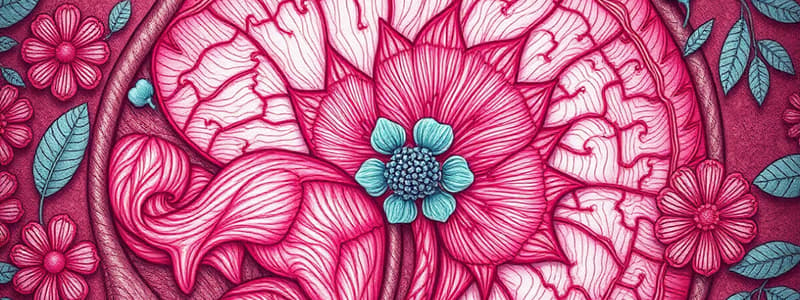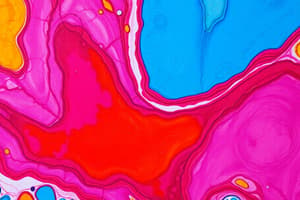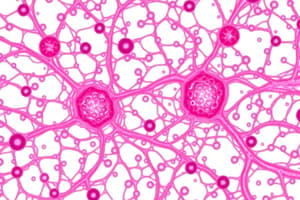Podcast
Questions and Answers
What are the general characteristics of muscle tissue?
What are the general characteristics of muscle tissue?
Muscle tissue is elongated in shape, derived from mesoderm, and the primary tissue responsible for motion due to its contraction property.
What is the unit of structure in muscle tissue?
What is the unit of structure in muscle tissue?
Elongated muscle cells or fibers.
Muscle cells require a rich network of blood capillaries.
Muscle cells require a rich network of blood capillaries.
True (A)
Which type of muscle tissue is striated and voluntary?
Which type of muscle tissue is striated and voluntary?
What is the structural and functional unit of skeletal muscle?
What is the structural and functional unit of skeletal muscle?
The connective tissue sheath that surrounds each muscle fiber is called the _____
The connective tissue sheath that surrounds each muscle fiber is called the _____
What proteins are thick filaments primarily made of?
What proteins are thick filaments primarily made of?
What is the role of troponin and tropomyosin in muscle contraction?
What is the role of troponin and tropomyosin in muscle contraction?
Describe the sliding filament theory of muscle contraction.
Describe the sliding filament theory of muscle contraction.
The neuromuscular junction is the connection between a motor neuron and a muscle fiber.
The neuromuscular junction is the connection between a motor neuron and a muscle fiber.
Flashcards are hidden until you start studying
Study Notes
UNIT EXPECTED OUTCOMES
- Ability to describe characteristics and functions of smooth, skeletal, and cardiac muscle tissues.
- Understanding the mechanism of muscle contraction in different muscle types.
- Skills to analyze histological images of muscle tissues.
GENERAL CHARACTERISTICS OF MUSCLE TISSUE
- Muscle tissue derived from mesoderm, fundamental for motion due to contraction.
- Structurally elongated muscle cells or fibers, often grouped in bundles.
- Connectivity provided by areolar connective tissue, creating a supportive framework.
- Sarcoplasm primarily composed of myofibrils, giving it a fibrillar appearance.
- Rich blood supply essential for muscle function.
- Muscle stains appear acidophilic, showing a pinkish hue.
SKELETAL MUSCLE
- Comprised of striated and voluntary muscle fibers attached to bones.
- Characterized by cylindrical, non-branching cells with flattened nuclei located peripherally.
- Organized into bundles called fascicles.
- Sarcoplasm contains myofibrils, organelles, lipid droplets, and glycogen granules.
- Myoglobin present in muscle gives it a distinctive brownish color.
- Sarcomere serves as the structural and functional unit, defined by the region between two Z lines.
CONNECTIVE TISSUE SHEATHS OF SKELETAL MUSCLE
- Endomysium: Surrounds each individual muscle fiber.
- Perimysium: Envelops groups of muscle fibers (fascicles).
- Epimysium: Encases entire muscles, comprising multiple fascicles.
MYOFIBRILS
- Make up approximately 80% of muscle cell volume.
- Serve as contractile elements arranged parallel to the muscle cell's long axis.
- Composed of repeating units called sarcomeres, which are the contractile unit characterized by Z lines.
MYOFILAMENTS
- Thick Filaments: Comprised mainly of myosin, located in the middle zone of the sarcomere, spanning A-band region.
- Thin Filaments: Primarily F-actin, attached to Z-lines, more numerous but shorter than thick filaments.
PROTEINS IN MYOFILAMENTS
- Thick Filaments: Made of myosin (60% total protein).
- Thin Filaments: Composed of F-actin, tropomyosin, and troponin, facilitating muscle contraction through regulation.
TRANSVERSE TUBULES AND SARCOPLASMIC RETICULUM
- Sarcoplasmic reticulum consists of flattened tubules that wrap around myofibrils.
- Transverse Tubules (T-tubules): Invaginations of sarcolemma at A-I band junction; two T-tubules encircle each sarcomere.
- Terminal Cisternae: Expanded regions of sarcoplasmic reticulum adjacent to T-tubules, contributing to calcium storage.
- Triad: Combination of one T-tubule and two terminal cisternae.
MOTOR ENDPLATE/MYONEURAL JUNCTION
- Connection point between motor neuron axon terminal and muscle fiber, where muscle contraction stimulation occurs.
- Comprising the axon terminal membrane, synaptic cleft, and motor endplate.
MOTOR UNIT
- Defined as a somatic motor neuron and the muscle fibers it innervates.
THE SLIDING FILAMENT THEORY OF MUSCLE CONTRACTION
- Myosin and actin filaments present in each muscle fiber, essential for contraction.
- Calcium ion influx into the sarcoplasm triggers the sliding of actin filaments past myosin, facilitating muscle contraction.
Studying That Suits You
Use AI to generate personalized quizzes and flashcards to suit your learning preferences.




